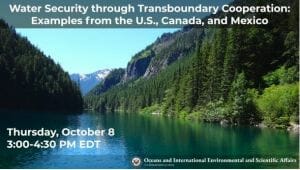Nov 9, 2020

The Bureau of Oceans and International Environmental and Scientific Affairs along with the U.S. State Department’s Bureau of Global Public Affairs hosted a webinar on October 8, 2020 to discuss one of the most important water issues facing our planet: transboundary water cooperation. The United States, Canada, and Mexico have a long history of working together to address water challenges, and therefore, are great examples of transboundary cooperation. The panel included Merrell-Ann Phare, Canadian Commissioner, International Joint Commission; Gilbert Trejo, Chief Technical Officer, El Paso Water and President of the WateReuse Association; Anne Castle, Senior Fellow, Getches-Wilkinson Center for Natural Resources, Energy, and the Environment, University of Colorado Law School; and moderator Melissa Meeker, Chief Executive Officer, The Water Tower.
Transboundary cooperation can be traced back to as early as 1889 when the United States and Mexico established the Bi-national International Boundary and Water Commission (IBWC). In 1909, the US and Canada established the International Joint Commission (IJC) and the Boundary of Waters Treaty.
Water management between the United States and Canada began with the Boundary of Waters Treaty and the IJC. The purpose of the treaty was to prevent and help resolve disputes over the waters shared by two countries in order to benefit the people of today as well as future generations. The IJC manages a wide range of transboundary issues including water levels and flows, water and air quality, and stakeholder management. These treaties, commissions, and the water that they govern affect millions of people, thousands of communities, tribal nations and ecosystems every day.
The IJC is mainly interested in the bodies of water that lie on the border of the US and Canada. Their main responsibilities include reviewing and approving projects that affect freshwater levels and flows across the boundary and investigating transboundary water issues and recommending solutions.
One of the biggest challenges facing the IJC is building climate resilience. When the Boundary of Waters Treaty was created in 1909, it was mostly about water quality and quantity. It did not address many other connected issues such as ecosystems, habitats, species, infrastructure longevity, etc. One tool that is helping to meet the challenge is the International Watershed Initiative which operates on an ecosystem focus. This initiative says that ecosystems function as whole entities and should be managed as such.
Indigenous engagement serves as an important part of the IJC. The Boundary Waters Treaty calls for consulting and engaging with everybody who was an interest in the waters being considered. Indigenous people not only have interests but also plenty of knowledge about many bodies of water. The Great Lake Water Quality Agreement specifically references indigenous nations, calls for coordination between all parties and governments including indigenous governments. The IJC has an Indigenous Commissioner and indigenous board members.
The United States and Mexico has a long history of managing the Colorado River system. The Colorado River is about 1500 miles and includes 7 US States and 2 states in Northwestern Mexico. The 1944 Treaty between the US and Mexico laid the foundation for how the two countries would manage the water. However, shortly after the treaty was signed, became a major problem which lead to the damaging of crops in Mexico.
The All-American Canal presented some problems between both countries when farmers suggested the lining of the canal to prevent seepage. This set off concerns for Mexico seeing that the seepage is one of the primary sources of recharge to the groundwater aquifer that supplies irrigation wells in the Mexican Valley. Congress had to intervene to settle the issue, and they chose to line the canal. An earthquake in 2010 devastated the irrigation infrastructure in the valley. The Mexican states had to call on the US to grant their request to defer the guaranteed delivery of water and store the water in the US.

Gilbert Trejo, Chief Technical Officer of El Paso Water and President of the WateReuse Association presenting during the virtual panel session.
This interaction changed up the shaky relationship between the US and Mexico and lead to new agreements between both countries such as join infrastructure projects and a one-time environmental pulse flow.
The El Paso and Juarez Mexico communities work together to effectively manage water. Texas requires a 50-year water plan. With constantly growing economy and population, Texas had a water supply of 158,000-acre feet as of 2018. The Hueco Bolson and Mesilla Bolson are two important aquifers that supply water to these communities. The Hueco Bolson is approximately 1.6 million acres in area. The current water supply comes from the Rio Grande, reclamation, underground water, conservation, and desalination. However, the hope for the future is that aquifer storage and recovery, advanced purification, and groundwater importation will supply the water in the future.
The United States, Mexico, and Canada have a long history of working together to properly manage transboundary bodies of water. These countries have been extremely successful which has been shown through many examples. Transboundary cooperation continues to be important because, as Melissa Meeker summarized, “it doesn’t matter where you are along a river, a lake, or an aquifer, we know water is precious and that it is critical to society, our well-being, our food, or economy, and frankly our lives.”
For more information, watch the webinar recording here.
The Water Tower is a new breed of innovation center providing answers to a multitude of complex challenges facing the water industry through an integrated approach to applied research, technology innovation, workforce development, and stakeholder engagement. With its mission to be a thriving ecosystem of water innovation fueled by imagination, informed by research, and powered by pioneers, The Water Tower is especially invested in helping utilities devise strategies to benefit from digital advancements in water supply and quality. For more information visit www.theh2otower.org
